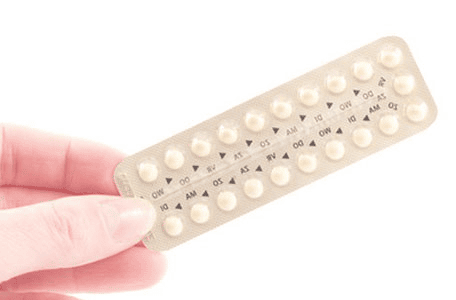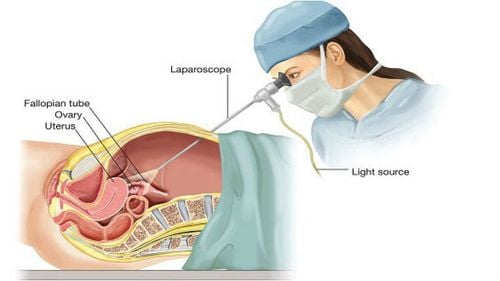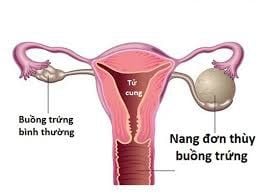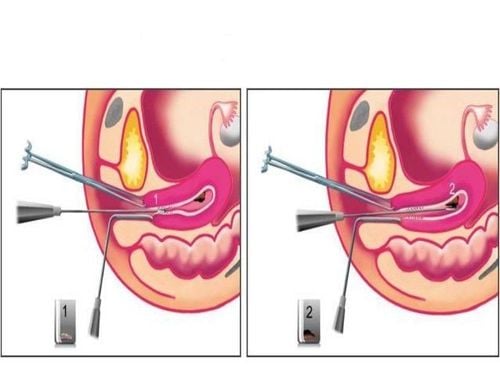This is an automatically translated article.
The article is professionally consulted by Master, Doctor Ton Nu Tra My - Department of Diagnostic Imaging - Vinmec Central Park International General Hospital. The doctor has many years of experience in the field of diagnostic imaging.Ovarian cyst is a very common gynecological disease in women of reproductive age. However, most patients will not know they have ovarian cysts until they have a gynecological examination with ultrasound.
1. Can ultrasound diagnose ovarian cysts?
Ultrasound is a diagnostic imaging technique that uses sound waves with frequencies as high as 20000Hz that cannot be heard by the human ear, to encode in the form of images of the internal structures of the body. These images will be displayed on the computer screen.In medicine, ultrasound is a common subclinical diagnostic technique and is often applied first to evaluate ovarian lesions, including ovarian cysts.
Ultrasound images can help your doctor tell if an ovarian cyst is present or not. More specifically, from these images, the doctor will identify the basic properties of the cyst such as shape, size, location, composition (liquid-filled, solid or mixed).
However, ultrasound images do not confirm with certainty whether the cyst is cancerous or not. Therefore, the patient will have to perform a few other diagnostic techniques such as: hormone level test, CA-125 level test, MRI cytology or tissue biopsy for accurate diagnosis and more comprehensively the condition of the cyst, helping to provide the right treatment.
2. When to go for an ultrasound of an ovarian cyst?
Some signs suspect you may have ovarian cysts such as: Menstrual disturbances, burning pain in the genitals, difficulty in going to the toilet, etc. So don't be subjective if you have one of them. If you have any of the above symptoms, you should see a doctor as soon as possible to ensure your own health.Usually, ultrasound to check for ovarian cysts will be applied to the following cases:
Women before marriage want to have an ultrasound to check the current status that affects fertility problems after getting married. kiss no. When there are abnormal signs in the reproductive system, suspected of having ovarian diseases or ovarian cysts should go for ultrasound to detect as soon as possible. Even if there are no abnormalities, an ultrasound of the uterus of the adnexa is recommended to be performed periodically during general physical examinations.

3. Technique, steps to perform ultrasound of ovarian cysts
Currently, there are two methods applied to diagnose ovarian cysts: abdominal ultrasound and transvaginal ultrasound:3.1. Abdominal ultrasound * Steps to conduct transabdominal ultrasound:
With the abdominal ultrasound method, the patient needs to lie on the bed, pull the shirt to chest level and pull the pants down to the pubic bone. Then, the doctor will use a transducer that can emit high-frequency sound waves in contact with the skin of the abdomen to capture an ultrasound image. The recorded images will be displayed on the screen to help doctors diagnose abnormalities in the ovaries. * Some notes:
Patients need to hold their urine to stretch their bladder, thereby making it easier for the doctor to observe and detect abnormalities in the pelvis, uterus or ovaries. * Advantages and disadvantages of abdominal ultrasound method:
+ Advantages:
Abdominal ultrasound is a fairly safe diagnostic technique, does not use radiation or X-rays, so it does not affect health patient. This is a non-invasive technique so there is no pain or discomfort for the patient. It only takes about 10-20 minutes to get the results done right away. + Disadvantages:
Abdominal ultrasound method is quite limited because it cannot fully check the status of ovarian cysts. The image is less clear when compared with transvaginal ultrasound.

* Steps to conduct transvaginal transvaginal ultrasound:
First, the patient will be instructed to lie on the bed or examination table, with both legs folded, a small pillow can be placed on the buttocks to create The position is favorable for the doctor to insert the transducer into the vagina. The transducer, wrapped in a condom with a lubricating gel, is slowly inserted into the vagina. The ultrasound transducer emits sound waves, which are then converted into images and displayed on a computer screen. * Some notes about transvaginal ultrasound:
Transvaginal ultrasound is usually indicated for women who have had sex or have given birth. This method does not apply to children, women who have not had sex, women who are in their menstrual cycle or have an acute infection in the vaginal area. The patient needs to urinate before the procedure to deflate the bladder to avoid pressing on the structures in the pelvis. Pros and cons of transvaginal ultrasound:
+ Advantages:
Although it may cause some discomfort, transducer ultrasound will give high-precision diagnostic images than transabdominal ultrasound. Therefore, this method will help doctors more accurately assess the patient's cyst status. This method is done quite quickly, only about 15-20 minutes and is safe even for pregnant women. + Disadvantages: Transvaginal ultrasound is only applicable to women who have had sex.

4. What does ultrasound mean for ovarian cysts?

Moreover, the ultrasound and early detection of ovarian cysts will help you get the results of treatment that preserves ovarian function with a high rate and the level of harm to health is also significantly reduced. Many cases of ovarian cysts but subjectively do not go to the doctor and treat them early, leading to having to remove one ovary with tumor or completely removing the ovary, leading to reduced fertility, even Permanent infertility entails many other consequences related to women's health.
Ultrasound is a modern imaging tool, bringing high accuracy to classify ovarian tumors. However, to get the most accurate ultrasound results, you need to choose a reputable performing facility, modern facilities, and a team of experienced and qualified medical professionals.
Currently, Vinmec International General Hospital systems have been using modern generations of color ultrasound machines. One of them is GE Healthcare's Logiq E9 ultrasound machine with full options, HD resolution probes for clear images, accurate assessment of lesions.
In addition, a team of experienced doctors and nurses will greatly assist in diagnosing and early detection of abnormal signs of the body in order to provide timely treatment.
Please dial HOTLINE for more information or register for an appointment HERE. Download MyVinmec app to make appointments faster and to manage your bookings easily.














